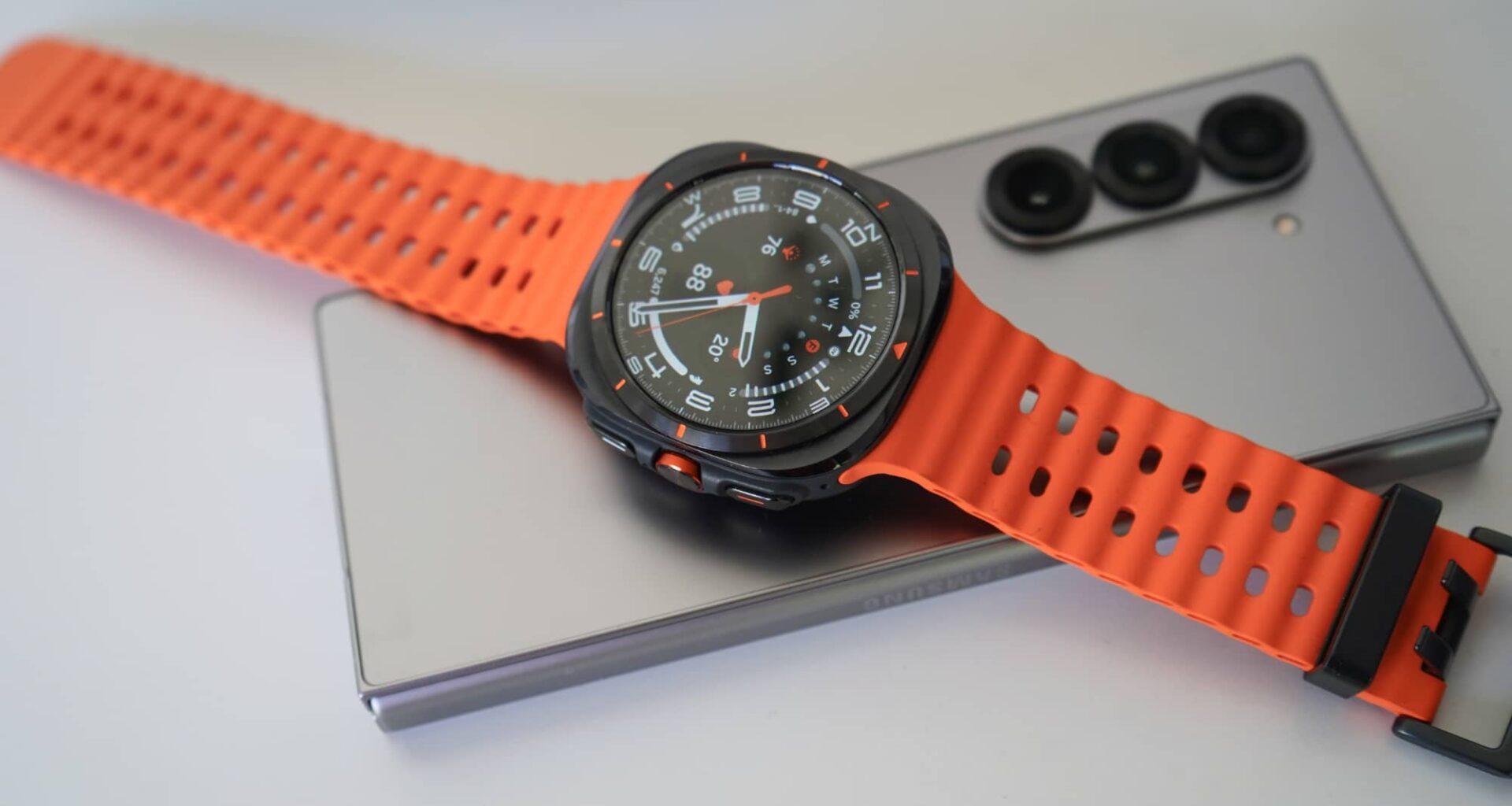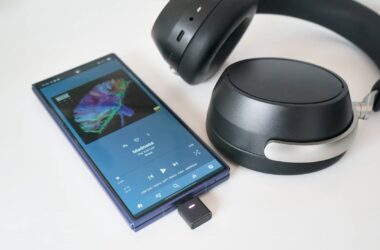Quick review
The good
The not-so-good
What happens when you marry the idea of the Apple Watch Ultra with the vibe of a Samsung Galaxy? You get the Galaxy Watch Ultra, an idea that still needs tweaks.
If there’s one thing that can help you decide on the phone you’re going to buy, it’s your choice of wearables. As good as they are, they typically are made to work with one operating system primarily, and sometimes might skip on the others.
Take the Apple Watch, any model: Apple’s smartwatch is designed to work solely with an iPhone and nothing else. You can set it up for kids without them needing an iPhone, but if you want to use it with an Android phone, there’s no chance of that. It’s a wearable that’s locked into the Apple ecosystem.
Samsung’s choice of wearables aren’t much different in that way.
They, too, are locked into an ecosystem, with Android being their target market, and mostly Samsung Galaxy Androids, at that. And while there have been a few of them, they’ve never touched the same market Apple’s Watch Ultra has sat in: a premium wearable featuring a titanium body and made for folks who live in their fitness and extreme adventures.
Fortunately for Android folks, Samsung now has one of those in the form of the Galaxy Watch Ultra, a rather unimaginatively named wearable that borrows from some of what Apple has made to deliver something for the Android crowd.
Is it exactly what Galaxy owners need, or is there better out there?
Design and features
What’s both a circle and a square? It turns out the answer to that one comes from Samsung, as the Galaxy Watch Ultra takes a curious spin on the regular Galaxy Watch design, as well as the design of another famous smartwatch and sizeable wearable.
Glance down at the top of Samsung’s Watch Ultra and it appears to be a circular frame and screen. Look just beyond that, and the typical circular screen is mounted to a square body, or more specifically, a squircle: the softened square many people were introduced to way back when Microsoft’s Zune announced it was using that shape.
We’ve seen squircles and softened squares and rectangles for some time now — Apple uses the shape on the Apple Watch, too — and Samsung’s Galaxy Watch Ultra is a curious blend of the two: circle up top, square on the bottom. Kinda sorta.
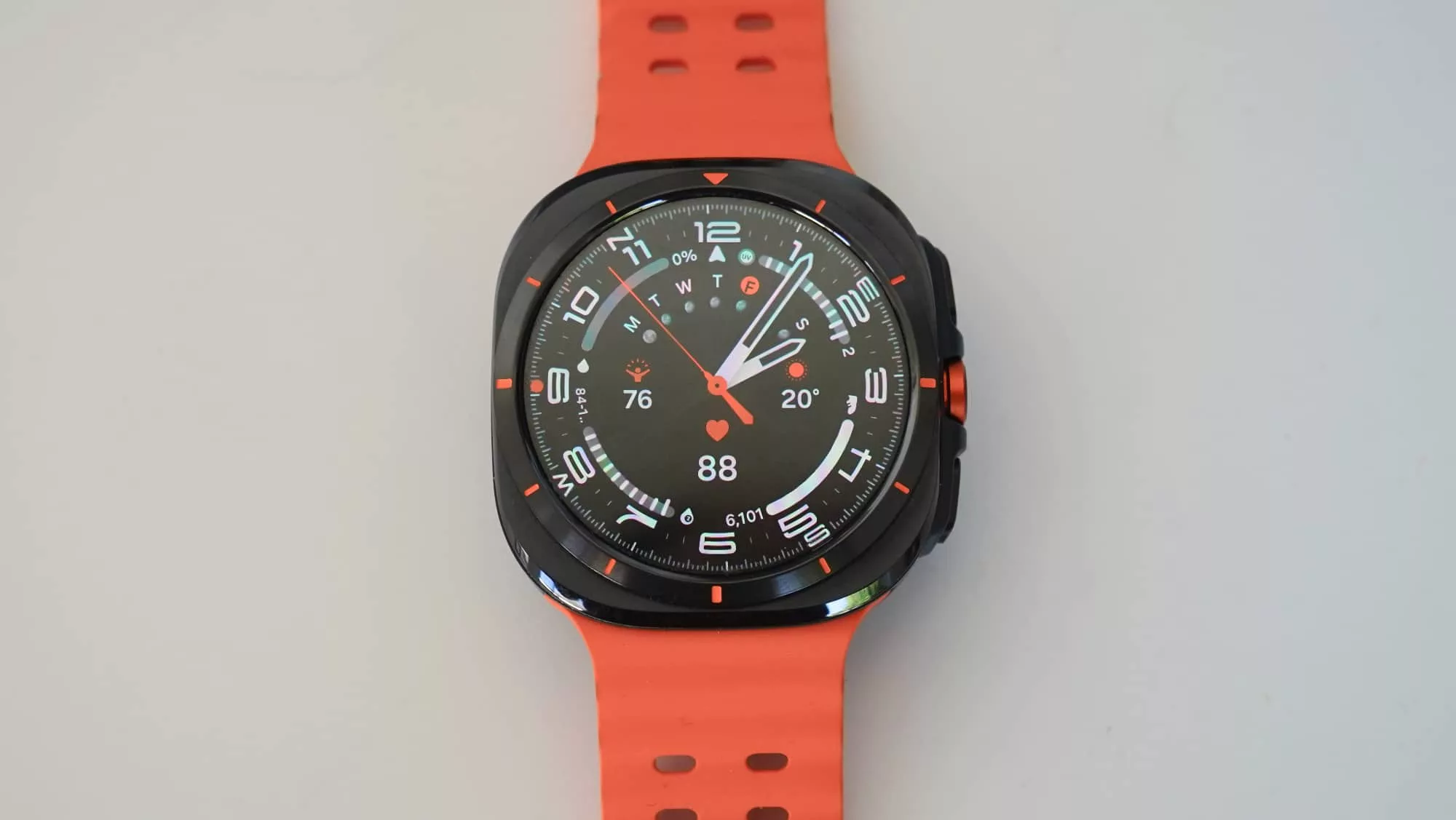
The circular top includes a pro-like watch rim with colour accents for each of the hours of the day — this is a watch, after all — and all of this is encased in a titanium frame that looks professional and sporty.
Inside, there’s a Samsung Exynos 5 core processor, 32GB storage, and Google’s Wear OS, with 5G native to the wearable alongside the standard of Bluetooth. There’s only one choice of watch size for the Galaxy Watch Ultra, with this thing measuring 47mm and featuring a 1.5 inch 450×450 screen, making it larger than the 44mm maximum of the other Galaxy Watch7 models, but technically the same as the maximum of the Galaxy Watch 6 Classic.
Different in spec from that model, you’ll also find a dual-frequency GPS system here, a speaker and microphone, a loud siren capable of hitting up to 86 decibels, and a durability rating of MIL-STD-810H (Military Spec) with IP68 water resistance and a water rating of 10ATM.
Charging the Watch Ultra relies on the same little circular disc we’ve seen in Samsung Watch models for some time, but it doesn’t seem any faster than those models, even if the Watch Ultra is the more premium of the bunch.
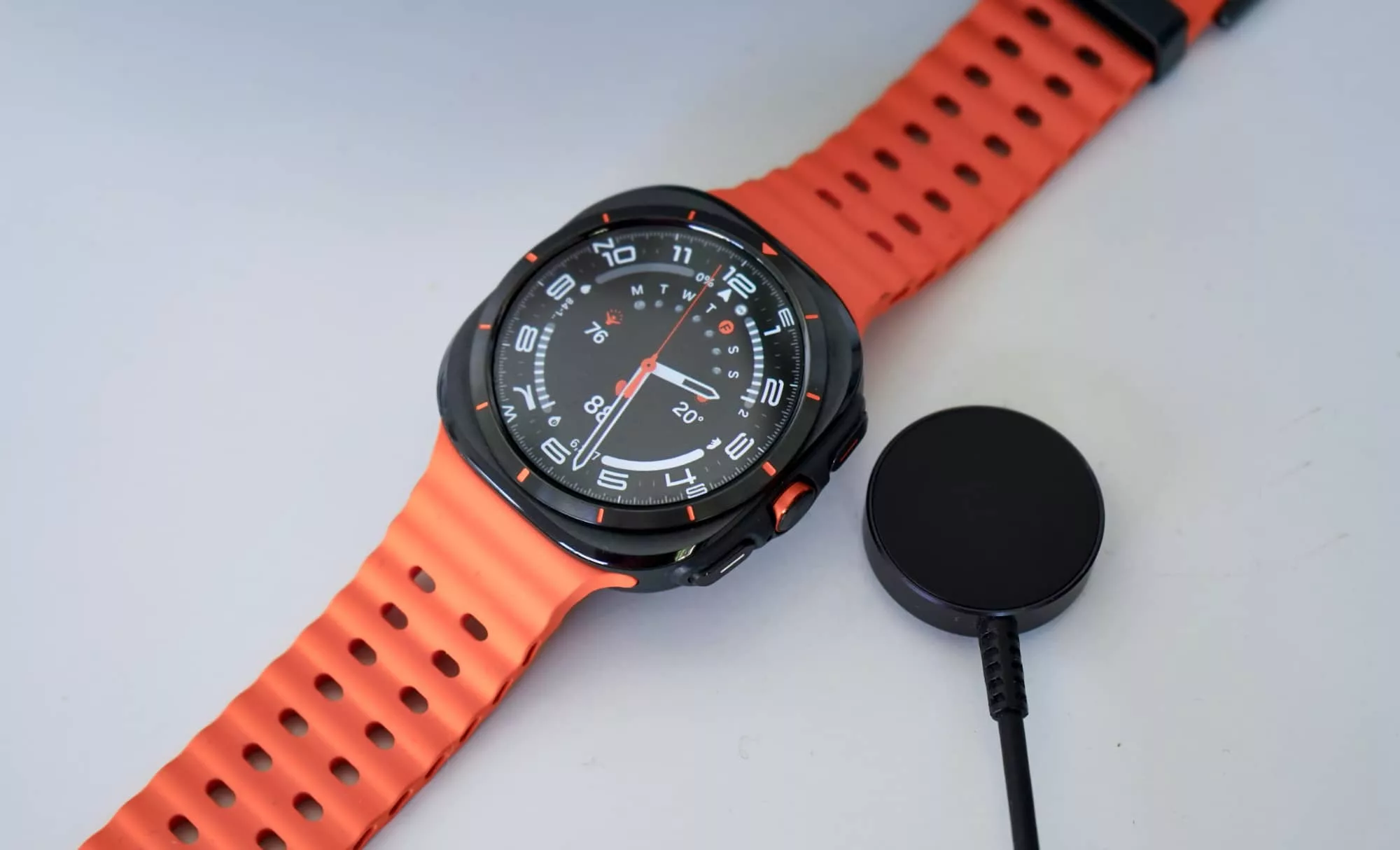
In-use
Using the Galaxy Watch Ultra is very much like Samsung’s other touchscreen-only Watch models, providing a circular touchscreen with gesture to control the screens, plus some buttons.
The top acts as both a back button and a long-press shortcut to Samsung’s Bixby voice assistant, while the bottom works for going back and also a long-press shortcut to trigger the watch’s wallet function.
In the middle is a circular extra function button which can be mapped to functions. By default, it’s set to trigger exercises from Samsung Health, but can be mapped to the stopwatch, torch, water lock, or just nothing.
In fact, all of the buttons can be mapped if you want more control over your watch. You can also use gestures, with a knock knock of the wrist loading an app or shortcut, a shake to dismiss something, and a double pinch in places, too.
The controls are easy enough to work out, though you may find muscle memory makes it difficult to recall what the buttons do. There may, in fact, be too many methods of control, with gestures like swiping down giving you easy access to the power control, while notifications and menus can be swiped in and out left and right. There’s a lot to remember here. Simplicity isn’t the name of the game, it seems.
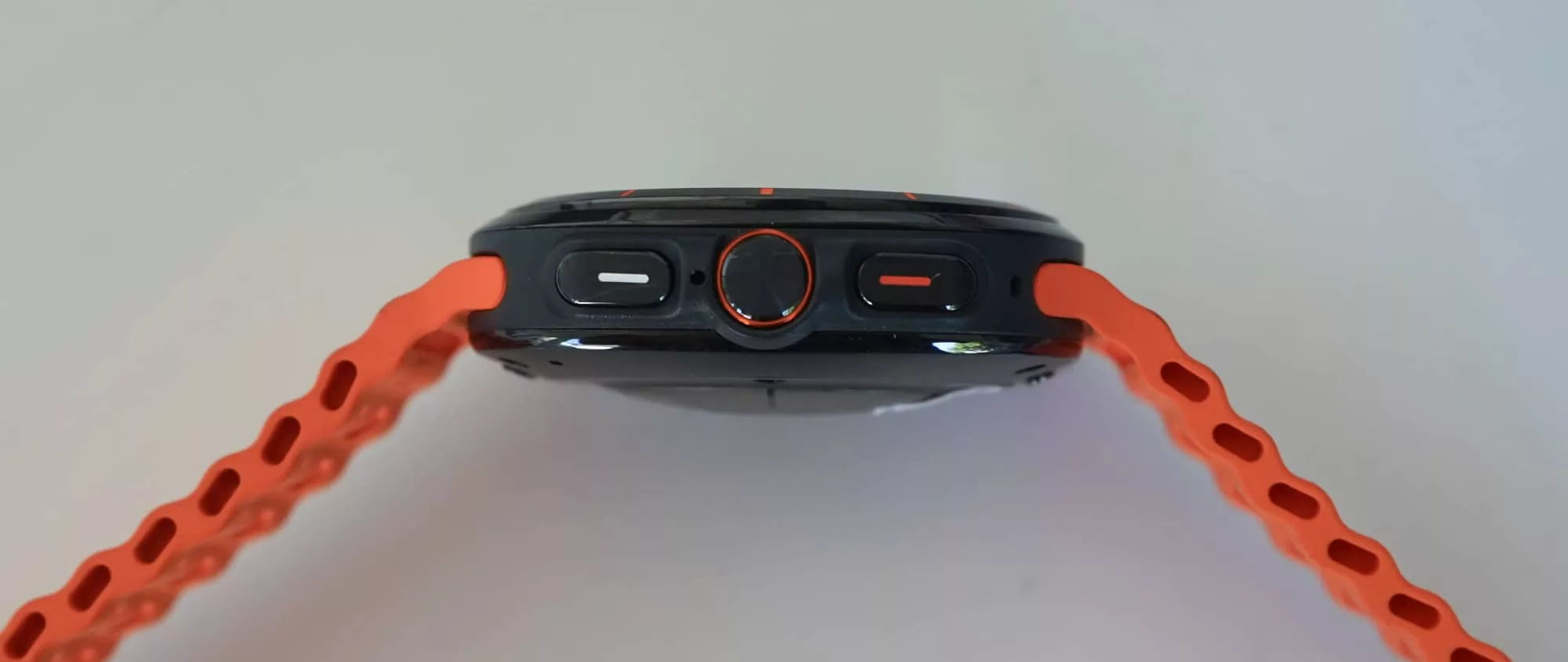
Performance
Wear the Galaxy Watch Ultra and you’ll find the sizeable 47mm watch is large, but fits comfortably if you’re used to a large watch.
There’s never to no lag in using it. In the time we spent reviewing this wearable, it was quick, responsive, and did everything we asked of it.
Of course, it works as a clock, and you’ll find a few clock faces with customisations, one of which even sports a red face for when the

Health capabilities
While the Galaxy Watch Ultra tends to be snappy for everything, you probably won’t think about the performance all that much.
No, you’ll be spending most of your time checking out your health, because outside of checking the time, that is the crux of using this thing, covering stress, health activity, and more.
Activities
Let’s start with activities, because they’re a part of the whole thing. Samsung’s Watch Ultra can track your activities automatically, but if you want to jump right into an activity, you can press the additional orange button which is pre-mapped to let you pick.
This reviewer is a walker, so that’s what he did: walked. He pressed the button, jumped into walking, and tracked that. You can clearly track more activity types, such as running, cycling, hiking, swimming, using a treadmill and elliptical trainer, weights, and so on. You can also add your own exercise.
Samsung has clearly put the focus on fitness with the Watch Ultra, and it definitely offers the screens in each to keep you on track: your stats, the time, and your music controller, all available from a gesture on the wearable.
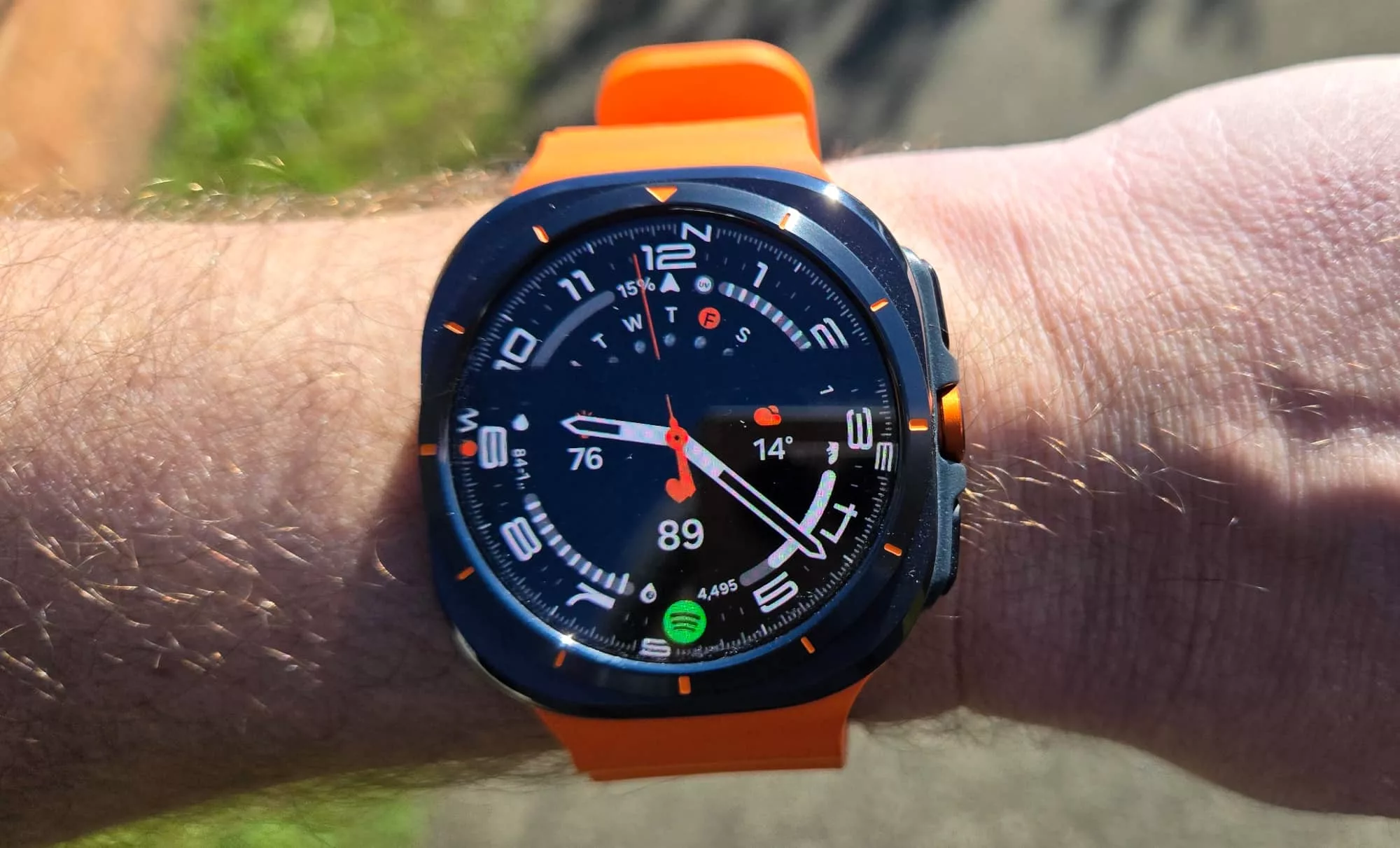
Whole health
The Galaxy Watch Ultra can also track your whole health, thanks to an assortment of sensors Samsung packages in its bioimpedance sensor. That includes some rather normal features such as blood oxygen, electrocardiograph, and heart rate, as well as the recently added temperature while sleeping.
Samsung also goes a little further with metabolic health, a factor it accounts for by measuring Advanced Glycation End Products or “AGEs”, something indicative of diet. This is one we’ll have to watch, but it’s an extra that forms a part of Samsung’s “Labs”, which is to say it might be helpful, but it is very much in testing.
You’ll also find an “energy score” complete with a cute little character which in my case told me to prioritise rest — clearly, it doesn’t have children — as well as extra factors Samsung Health can factor in that aren’t tabulated by the watch, a such as blood glucose and blood pressure.
There’s no blood pressure monitor cuff directly in the Galaxy Watch Ultra, but if you have a cuff, you can check your pressure while wearing the Galaxy Watch three times in the space of half an hour to get the wearable understanding how to measure your blood pressure.
It works, that much we can confirm, but based on the readings we saw, we suspect your actual blood pressure cuff is going to be more reliable in the long term. Think of this as just an extra.
Sleep
One area we didn’t see eye-to-eye with was the sleep tracking. The sheer concept of “sleep” has gone a little awry lately with Ms 2 having a bit of a sleep regression. However, that’s helping us to test how legitimate the Galaxy Watch Ultra’s sleep tracking really is.
Unfortunately, we found it can report that you’ve spent time lying in bed when that isn’t what has happened at all. In our case, it managed to think we had spent eight hours in bed when there was a full two hours we’d been walking around, picking up the child, rocking her, cuddling her, and sitting upright. None of these actions are remotely like lying in bed, and yet Samsung’s sleep algorithms remained unconvinced.
Meanwhile, the Apple Watch Ultra was able to pick up on the reviewer not being in bed, even though Samsung’s Galaxy Watch Ultra insisted we were. Weirdly, the graph on the watch communicated roughly the right thing, even if Samsung’s words were wrong. Clearly, there are some bugs that need fixing.
The Galaxy Watch Ultra also includes sleep apnoea tracking, though that’s something we need more time with, if only so we can achieve sleep (what’s that?).
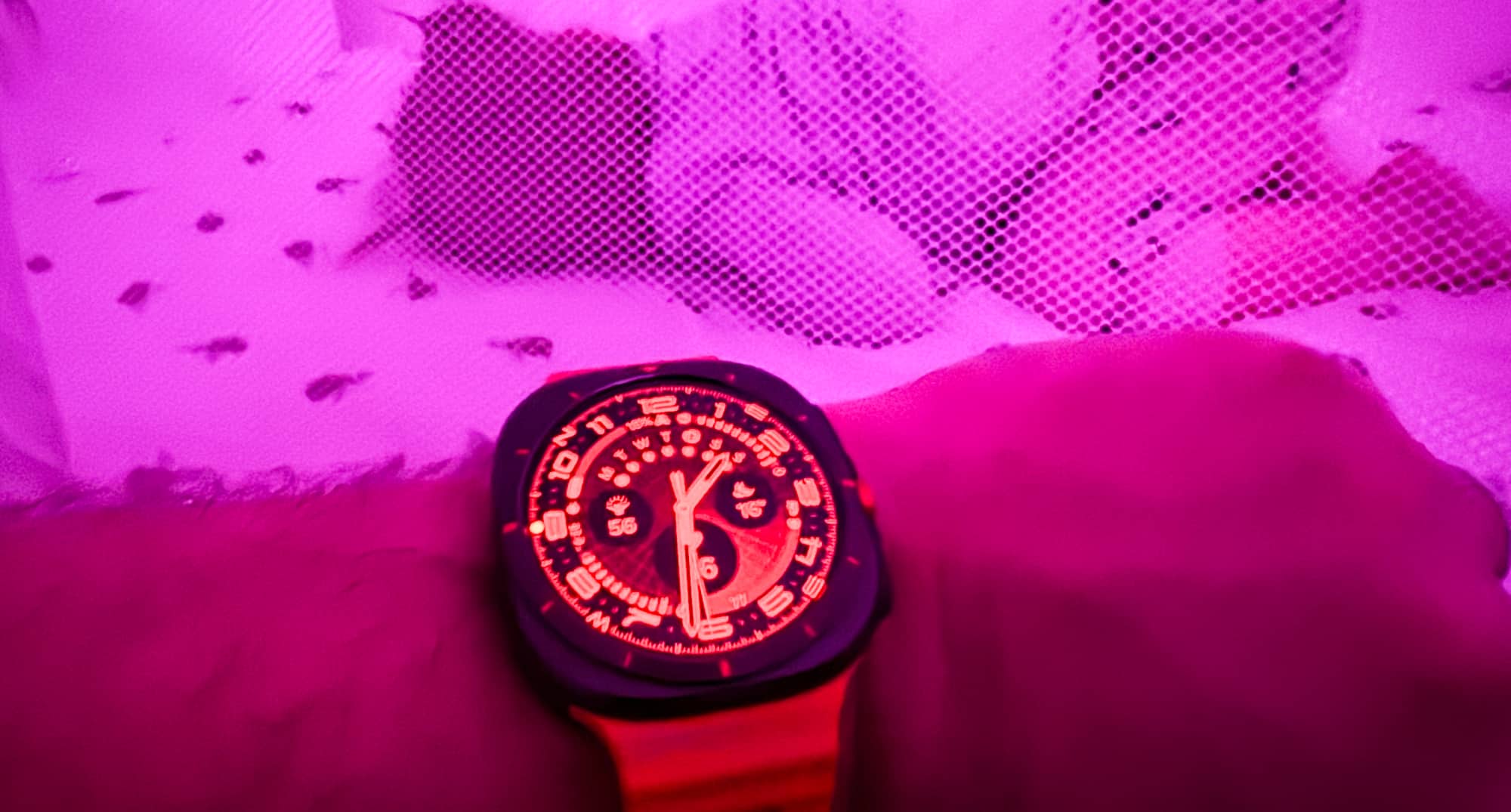
Battery
Fortunately, the battery saves the day. Samsung quotes up to 100 hours with a power saving mode, while an exercise mode for the GPS gets up to 48 hours.
In our time reviewing the Galaxy Watch Ultra, we found its 590mAh battery could achieve a little over 48 hours, particularly if you just use the Watch Ultra as a wearable and let it give you the time, track fitness, track health, and provide notifications.
Believe it or not, that included having an always-on watch that was pretty much always on, though some times when we glanced over, it was clear it wasn’t. Probably another bug.
In total, we found 52 hours before we felt compelled to send it back to the charger, but if we wanted to live the rest of the day, we suspect low power mode would have managed to get us close to 72 hours.
Not too shabby, especially given most wearables struggle to close on a full 48 hours at all.
You could theoretically run the Samsung Watch Ultra in that low power mode only for several days of life, though you might have to omit some of the niceties you’re buying the watch for in the first place.

Value
That price, however, is on the high side, hardly a surprise given the titanium frame and meaty battery life. At $1299 in Australia, Samsung has largely matched the obvious other Watch Ultra, which isn’t far off at $1299.
What you get for that is a better Galaxy Watch, no doubt about that, but some of those features might not seem like much of an extra. Samsung normally incudes sapphire glass so that’s not exactly new, but you’re paying for the design, the sizeable battery, and even the mobile capability which is built-in and the only model you can get of the Galaxy Watch Ultra.
Beating the Apple Watch Ultra by a hundred bucks is something, sure, but given Android users can’t use an Apple Watch of any kind, it’s also largely an irrelevant point.
Overall, the price isn’t terrible for a sizeable activity-focused smartwatch, as these tend to cost over $1000 in general, sometimes hitting as high as $1700 and more. That’s not terrible in the grand scheme of things.
And hey, it definitely gives Android users something they may have been looking for: a Watch Ultra variation for their choice in operating system.
What needs work?
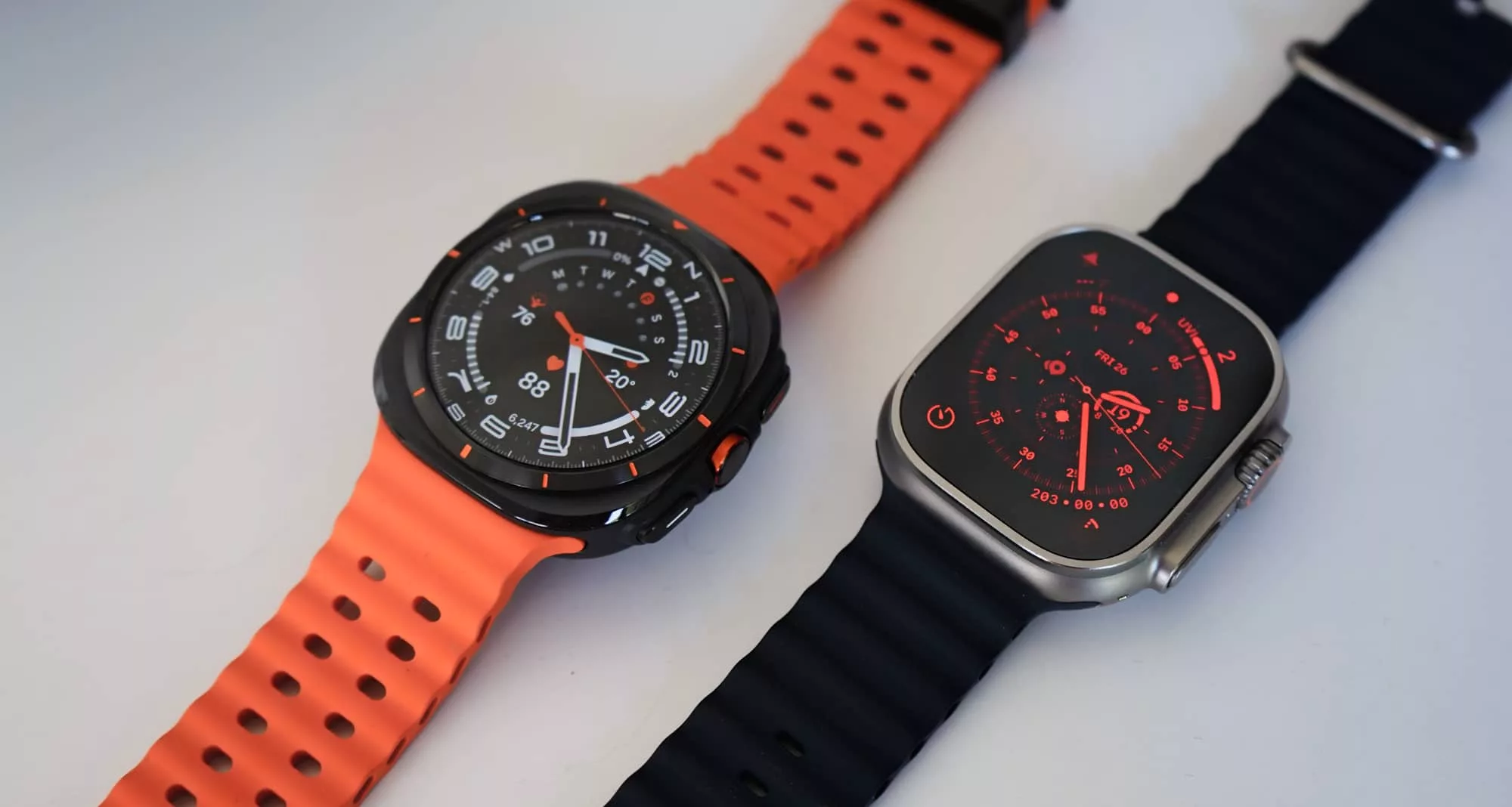
One thing we’d have loved from the “ultra” Galaxy Watch would have been some personality of its own, which feels so much like Samsung has just said “yeah, nah”.
The circular watch face is a hallmark of the Galaxy Watch, and has been ever since it launched as the Gear. One of our favourite wearables, the Gear S3, used the concept and even came complete with the clever ring controller up top. These days the ring controller can be found in the Galaxy Watch Classic models, which was updated in last year’s Galaxy Watch 6 Classic but won’t be this year.
Make no mistake, the Galaxy Watch Classic is Samsung using clever design. But not so much with the Galaxy Watch Ultra.
Glance at the Galaxy Watch Ultra and you’d be excused for thinking it’s a Galaxy Watch circular screen shameless mounted on an Apple Watch Ultra squircle body… because it largely is.
It exudes practically nothing about previous Samsung’s Galaxy Watch models which made them unique, and you only have to wonder what the designers inside Samsung have to say about the matter. We imagine they’re probably rolling their eyes.
It’s a look that will divide, that’s for sure. As a reviewer, I am less enthused by this design than I was the simplicity of other Galaxy Watch models.
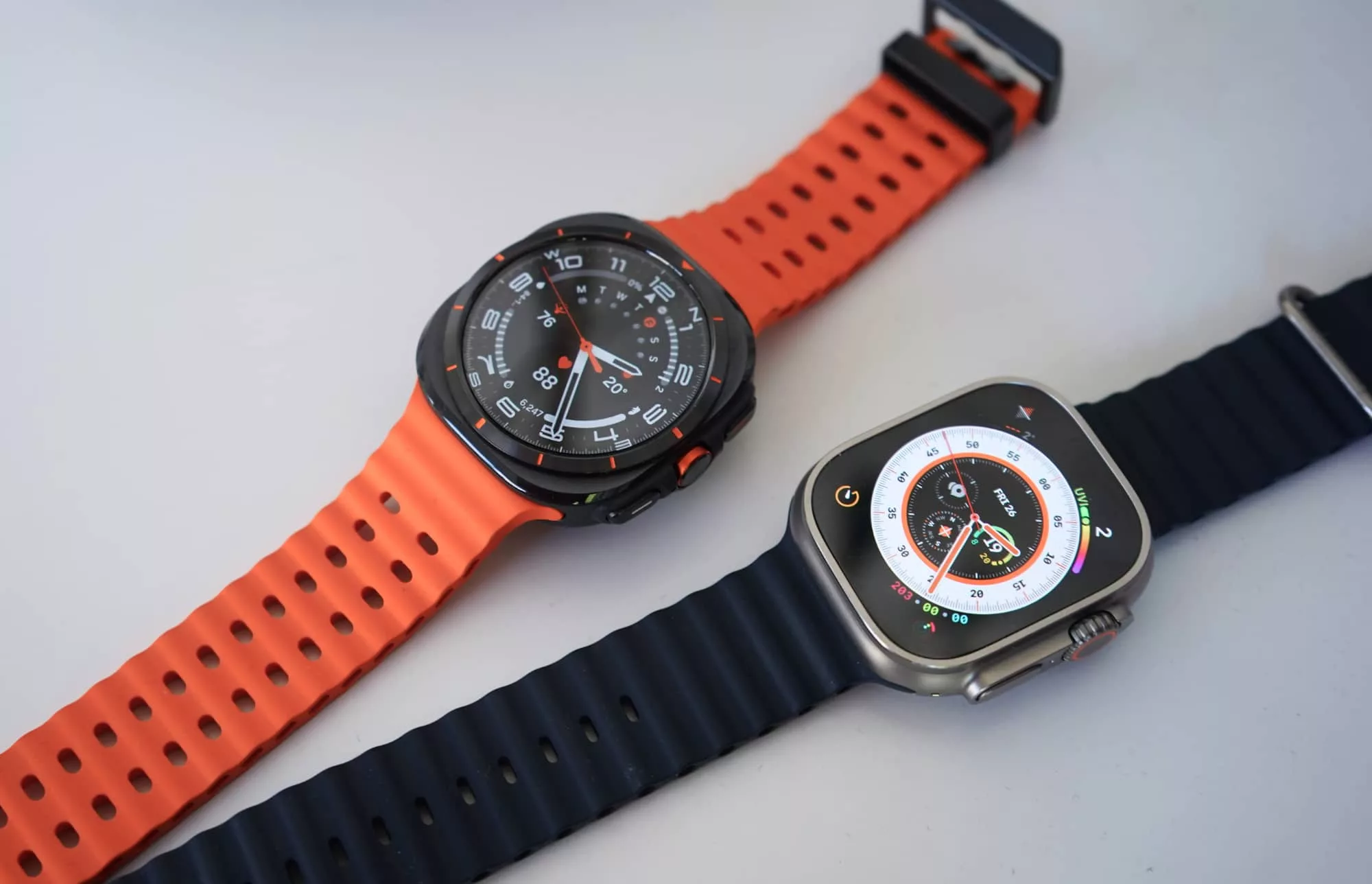
I wanted so desperately for the Galaxy Watch Ultra to be Samsung’s best interpretation of what Apple had made so well for the first Watch Ultra: I wanted a slightly thicker circular display for more battery, the titanium body, the ring wheel up top in a chrono-style, and a feeling that it was an even-more premium Galaxy Watch Classic.
I didn’t want to see a Samsung Watch mounted to an Apple, and yet that’s exactly what it feels like, right down to the obvious orange function button and the even more obvious orange and blue watch straps. It’s kind of surreal, but not necessarily in a good way.
In fact, it’s similar in other ways: a distinctly different approach to clipping bands in compared to other Galaxy Watch models, a water mode that sounds a little like the Apple Watch version of the same, the red-lit clock face that loads in dark.

That change in band leads to other issues, namely that you will need all new bands, even if you’re coming from a previous Galaxy Watch model. That’s thanks in part to Samsung’s new clipped band design, which is different from the pin used on the regular Galaxy Watch models.
Meanwhile, Apple Watch owners have seen models the bands from the 45mm Series 7, Series 8, and Series 9 models work on the Apple Watch Ultra and Ultra 2, so there’s a clear point of distinction here.
In short, Samsung hasn’t necessarily thought of previous owners in this model, and if you want more watch bands, you can’t just recycle up.
There’s no Apple Watch Ultra for any phone that isn’t an iPhone. However, if what you wanted was the Apple Watch Ultra for an Android, the Galaxy Watch Ultra is about as close it gets.

Galaxy Watch Ultra 2 vs the competition
The problem is that may not be good enough.
The Apple Watch Ultra feels more rounded and complete, but since it’s not really a competitor given the lack of Android support, that’s not a major competitor beyond brand and reputation.
However, Garmin’s Fenix and Epix range does offer competition, albeit for slightly higher prices. Built in titanium and arriving with up to 22 days of battery life, there’s are variations that include solar recharging for its equally big 47mm screen.
You won’t find a smart interface like Wear OS on the Garmin models, nor will you find it on the other obvious equivalent from Withings, the ScanWatch Nova, but it also offers a roughly two week battery life for the near same price.
That’s where the competition for the Samsung Watch Ultra really is: solid Android-friendly wearables that forgo the clever OS with payment support, instead replacing it with something that’s still ideal for fitness and health yet comes with heaps of battery life. It’s a difference, for sure.
Samsung even has competition in its own wearable,s whether it’s the slightly older $749 stainless steel 47mm Galaxy Watch 6 Classic or the slightly newer but less durable $699 aluminium Galaxy Watch 7 variation. Between the Galaxy Watch Ultra and its Galaxy Watch 7 sibling, some of the features line up, begging you to ask whether the size, improved battery life, and titanium casing are really worth the $500 or so difference.
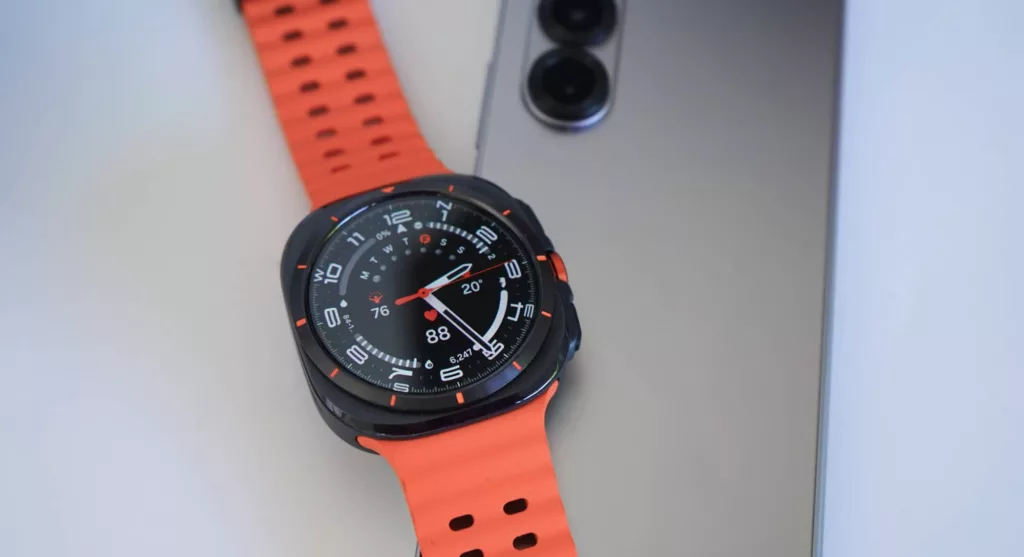
Final thoughts (TLDR)
Probably the best part about the Samsung Galaxy Watch Ultra is what it delivers: a premium smartwatch experience with Google’s latest WearOS. That has largely been missing in action.
There’s no shortage of premium wearables, but Android-friendly premium wearables? They’re more difficult to find.
And while we’re not exactly enamoured with the look of this model, largely because it lacks its own personality, the Galaxy Watch Ultra does deliver what many in the Android camp were looking for, particularly if they own a Samsung phone: a wearable experience that rivals Apple’s own Ultra premium gear.
That’s close to what this is, too: a premium Galaxy wearable made to monitor your health. There are things that could be improved upon, but if what you’re after is the Apple Watch Ultra for your Galaxy life, this is it.



